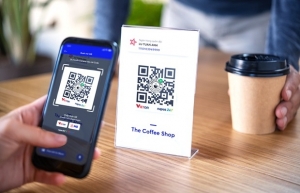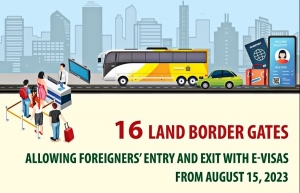Tourists the winners in payment advances
 |
| Southeast Asia, energised by pandemic-driven digital transformation, is rapidly evolving into a hub for digital payments and other digital services. This shift is propelled by widespread mobile ownership and accelerated digitalisation across countries like Singapore, Malaysia, Thailand, Indonesia, the Philippines, Brunei, Laos, Cambodia, and Vietnam. Innovations such as Thailand’s PromptPay, the Philippines’ use of digital platforms for COVID-19 aid, and Singapore’s push for QR code payments are prime examples. Digital wallet transactions in the region, which stood at $22 billion in 2019, are expected to surpass $114 billion by 2025. This trend indicates a declining reliance on cash, with digital payments now constituting over half of all transactions in the region. Source: PwC |
Payment giant Visa in December partnered with Tencent, allowing cardholders worldwide to link their cards directly with WeChat Pay and Alipay for transactions in China.
Dang Tuyet Dung, country manager for Visa in Vietnam and Laos, highlighted, “Vietnamese consumers travelling in China can now enjoy seamless payment transactions at millions of outlets across more than 400 cities on the mainland. This convenience extends to major Chinese online retail destinations and mobile apps.”
Users of WeChat Pay and Alipay can choose from multiple transaction methods, including QR code scanning and in-app payments, enhancing the user experience with convenience and flexibility.
“Historically, Alipay and WeChat Pay had restricted integration with international payment cards until July when they opened doors to Visa, Mastercard, JCB, and Discover cards,” an industry insider said.
Meanwhile, domestic payment players are also setting their sights high, aiming to expand their reach and influence across the region.
National Payment Corporation of Vietnam (NAPAS) has also collaborated with several banks to facilitate cross-border QR code payment services. As a result, clients of BVBank, Nam A Bank, Sacombank, VietinBank, Vietcombank, BIDV, and TPBank have the ability to execute QR code payments in Thailand.
“This service is available through their respective banking apps at merchant points associated with the Thai National ITMX, recognisable by the Promptpay symbol or the logos of Thai banks such as Bangkok Bank, SCB Bank, KasikornBank, and Krung Thai Bank,” a representative of NAPAS stated. “Transactions are converted from Thai baht to VND based on the prevailing exchange rate at the time of the transaction.”
Vietnam has also made significant strides by joining the regional payment connectivity initiative. In August, the State Bank of Vietnam (SBV) signed an MoU on regional payment connectivity cooperation with the central banks of Indonesia, Malaysia, the Philippines, Singapore, and Thailand.
Deputy Governor of the SBV, Pham Thanh Ha, highlighted the importance of this move in bolstering Vietnam’s position as a key travel destination in Southeast Asia.
“Joining this regional payment connectivity initiative marks a significant milestone for Vietnam, especially in terms of enhancing convenience and supporting our burgeoning tourism sector,” Ha said.
“The pact stipulates that member central banks will promote cross-border payment connectivity using methods such as QR codes, instant payments, and other payment models, along with cooperation in supervision and the development of sound risk management mechanisms, in line with the legal frameworks of the member countries,” Ha added.
Under the terms of the MoU, participating ASEAN banks commit to enhancing cross-border payment connectivity, aiming for faster, more transparent, inclusive, and cost-effective transactions.
Pham Phuong Anh, marketing director of Du Lich Viet, believed that payment convenience would be a major boost for both outbound and inbound tourism.
“For Ho Chi Minh City only, we’re projecting a revenue surge of over 40 per cent in 2024 compared to 2023. Additionally, we are broadening our network of strategic partnerships to ensure competitive pricing and are intensifying our involvement in promotional and marketing initiatives,” Anh said.
 | Electronic payment continues to flourish in Vietnam The trend of electronic and non-cash payments in the Vietnamese economy in 2023 continued to record growth of 52.35 per cent in volume over the same period last year. |
 | 16 land border gates allow foreigners’ entry and exit with e-visas The following 16 land border gates permit foreigners to enter and exit Vietnam with e-visas from August 15, 2023 under a recent Government’s decision. |
 | Thai, Chinese firms tie up in cross-border payment TrueMoney, a leading fintech company in Thailand, has partnered with Ant Group of China to launch cross-border mobile payments between Thailand and China, allowing Thai tourists to use TrueMoney e-wallet to make payments to tens of millions of merchants in China. |
 | AI can reshape Vietnam’s payment landscape Vietnam's payment landscape is set to undergo significant transformation through the use of generative AI, according to Visa. |
What the stars mean:
★ Poor ★ ★ Promising ★★★ Good ★★★★ Very good ★★★★★ Exceptional
Related Contents
Latest News
More News
- The destinations powering Vietnam’s festive season travel demand (December 04, 2025 | 18:33)
- Vietnam named among the world’s most exciting winter destinations (December 04, 2025 | 15:10)
- Phu Tho emerges as northern Vietnam’s new tourism hub (December 01, 2025 | 17:00)
- Vietjet completes Airbus A320/A321 updates ahead of deadline (December 01, 2025 | 09:49)
- Vietjet resumes Con Dao flights from early December (November 28, 2025 | 15:24)
- Free tickets, Lunar New Year promotions on offer at Vietjet Mega Livestream (November 26, 2025 | 15:32)
- Scandinavian Airlines and Vietnam Airlines broaden agreement with new routes (November 25, 2025 | 17:04)
- Halong Cruise Port welcomes over 3,100 international visitors (November 12, 2025 | 18:06)
- Vietnam.travel climbs to second place in Southeast Asia website rankings (November 12, 2025 | 18:01)
- Cat Ba named among Southeast Asia’s top island adventures (November 11, 2025 | 18:09)

 Tag:
Tag:





















 Mobile Version
Mobile Version